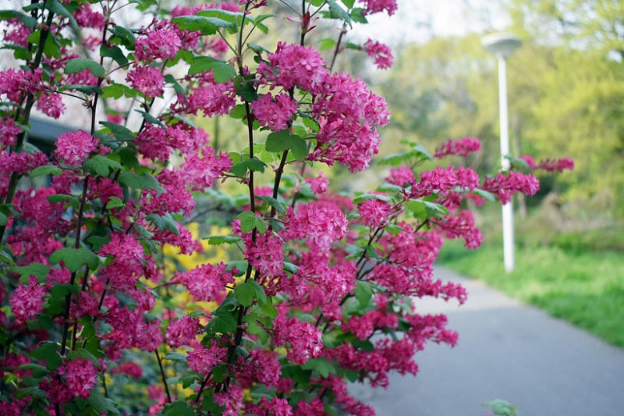

Redflower Currant, Blood Currant, Pink-flowered Currant, Red Flowering Currant, Ribes glutinosum, Coreosma sanguinea, Calobotrya sanguinea
Ribes sanguineum (Red Flowering Currant) is a medium-sized, bushy deciduous shrub noted for its abundant showy flowers and fall berries. In early to mid spring, drooping clusters of 10-30 small, pink to deep red flowers occur along the length of the stems. They literally smother the shrub and create a great floral display. They are followed by small blue-black berries covered with a thin white waxy coating, holding about 20 seeds each. Although very tart, the berries are suitable for jam, jelly, pie, juice or syrup. The attractive foliage of rounded, 3-5 lobed, dark green leaves turns shades of yellow and red in fall. The leaves release a strong resinous scent when crushed. The thin orange or red tinted bark turns gray-brown and peels from older stems. Native to western coastal North America, Red Flowering Currant is commonly found in open woods, forest gaps, dry rocky slopes and disturbed sites from sea level up to 6,000 ft. It is attractive as a landscape specimen or informal hedge. It is also useful in restoration plantings and perfect for wildlife gardens. Red Flowering Currant provides early spring nectar for hummingbirds and butterflies, forage many species of moths and butterflies, and nesting sites or cover for songbirds and small mammals. Numerous birds and small mammals consume the berries.
| Requirement | |
|---|---|
| Hardiness | 6,7,8 |
| Heat Zones | 6,7,8 |
| Climate Zones | 4, 5, 6, 7, 8, 9, 10, 14, 15, 16, 17, 18, 19, 20, 21, 22, 23, 24, A3 |
| Plant Type | Shrubs |
| Plant Family | Grossulariaceae |
| Exposure | Full Sun, Partial Sun |
| Season of Interest | Spring, Fall, Early Spring, Mid Spring |
| Height | 5' - 6', 6' - 7', 7' - 8', 8' - 9', 9' - 10' |
| Spread | 5' - 6', 6' - 7', 7' - 8', 8' - 9', 9' - 10' |
| Water Needs | Average |
| Maintenance | Low |
| Soil Type | Chalk, Clay, Loam, Sand, Acid, Alkaline, Neutral |
| Characteristics | Attracts Butterflies, Attracts Hummingbirds, Deer Tolerant, Drought Tolerant |
| Garden Styles | Informal and Cottage |
| Planting Place | Hedges and Screens, Rain Gardens |